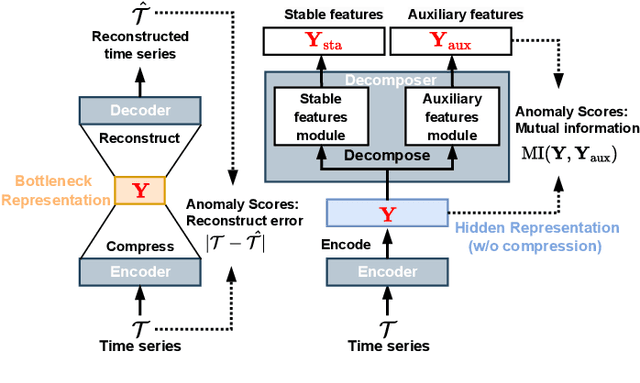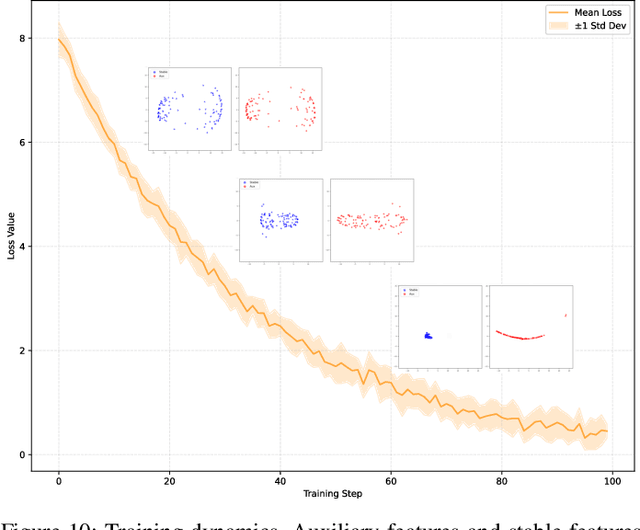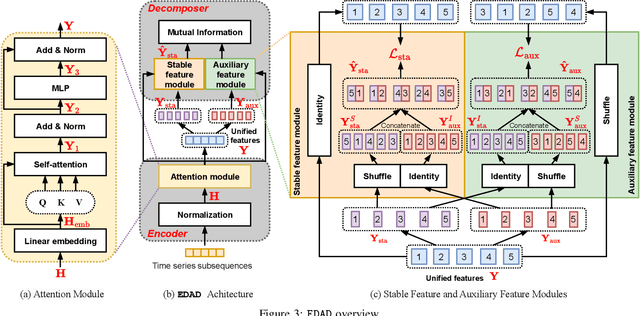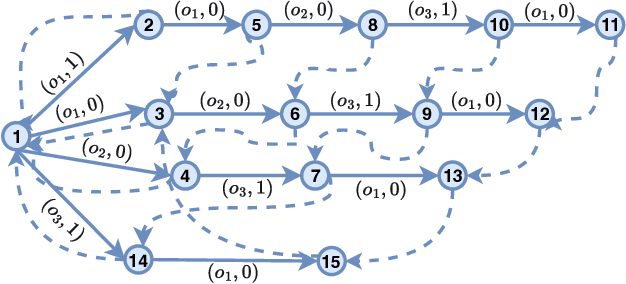Christian S. Jensen
An Encode-then-Decompose Approach to Unsupervised Time Series Anomaly Detection on Contaminated Training Data--Extended Version
Oct 21, 2025



Abstract:Time series anomaly detection is important in modern large-scale systems and is applied in a variety of domains to analyze and monitor the operation of diverse systems. Unsupervised approaches have received widespread interest, as they do not require anomaly labels during training, thus avoiding potentially high costs and having wider applications. Among these, autoencoders have received extensive attention. They use reconstruction errors from compressed representations to define anomaly scores. However, representations learned by autoencoders are sensitive to anomalies in training time series, causing reduced accuracy. We propose a novel encode-then-decompose paradigm, where we decompose the encoded representation into stable and auxiliary representations, thereby enhancing the robustness when training with contaminated time series. In addition, we propose a novel mutual information based metric to replace the reconstruction errors for identifying anomalies. Our proposal demonstrates competitive or state-of-the-art performance on eight commonly used multi- and univariate time series benchmarks and exhibits robustness to time series with different contamination ratios.
Advancing Knowledge Tracing by Exploring Follow-up Performance Trends
Aug 11, 2025



Abstract:Intelligent Tutoring Systems (ITS), such as Massive Open Online Courses, offer new opportunities for human learning. At the core of such systems, knowledge tracing (KT) predicts students' future performance by analyzing their historical learning activities, enabling an accurate evaluation of students' knowledge states over time. We show that existing KT methods often encounter correlation conflicts when analyzing the relationships between historical learning sequences and future performance. To address such conflicts, we propose to extract so-called Follow-up Performance Trends (FPTs) from historical ITS data and to incorporate them into KT. We propose a method called Forward-Looking Knowledge Tracing (FINER) that combines historical learning sequences with FPTs to enhance student performance prediction accuracy. FINER constructs learning patterns that facilitate the retrieval of FPTs from historical ITS data in linear time; FINER includes a novel similarity-aware attention mechanism that aggregates FPTs based on both frequency and contextual similarity; and FINER offers means of combining FPTs and historical learning sequences to enable more accurate prediction of student future performance. Experiments on six real-world datasets show that FINER can outperform ten state-of-the-art KT methods, increasing accuracy by 8.74% to 84.85%.
MH-GIN: Multi-scale Heterogeneous Graph-based Imputation Network for AIS Data (Extended Version)
Jul 27, 2025Abstract:Location-tracking data from the Automatic Identification System, much of which is publicly available, plays a key role in a range of maritime safety and monitoring applications. However, the data suffers from missing values that hamper downstream applications. Imputing the missing values is challenging because the values of different heterogeneous attributes are updated at diverse rates, resulting in the occurrence of multi-scale dependencies among attributes. Existing imputation methods that assume similar update rates across attributes are unable to capture and exploit such dependencies, limiting their imputation accuracy. We propose MH-GIN, a Multi-scale Heterogeneous Graph-based Imputation Network that aims improve imputation accuracy by capturing multi-scale dependencies. Specifically, MH-GIN first extracts multi-scale temporal features for each attribute while preserving their intrinsic heterogeneous characteristics. Then, it constructs a multi-scale heterogeneous graph to explicitly model dependencies between heterogeneous attributes to enable more accurate imputation of missing values through graph propagation. Experimental results on two real-world datasets find that MH-GIN is capable of an average 57% reduction in imputation errors compared to state-of-the-art methods, while maintaining computational efficiency. The source code and implementation details of MH-GIN are publicly available https://github.com/hyLiu1994/MH-GIN.
Prioritizing Alignment Paradigms over Task-Specific Model Customization in Time-Series LLMs
Jun 13, 2025Abstract:Recent advances in Large Language Models (LLMs) have enabled unprecedented capabilities for time-series reasoning in diverse real-world applications, including medical, financial, and spatio-temporal domains. However, existing approaches typically focus on task-specific model customization, such as forecasting and anomaly detection, while overlooking the data itself, referred to as time-series primitives, which are essential for in-depth reasoning. This position paper advocates a fundamental shift in approaching time-series reasoning with LLMs: prioritizing alignment paradigms grounded in the intrinsic primitives of time series data over task-specific model customization. This realignment addresses the core limitations of current time-series reasoning approaches, which are often costly, inflexible, and inefficient, by systematically accounting for intrinsic structure of data before task engineering. To this end, we propose three alignment paradigms: Injective Alignment, Bridging Alignment, and Internal Alignment, which are emphasized by prioritizing different aspects of time-series primitives: domain, characteristic, and representation, respectively, to activate time-series reasoning capabilities of LLMs to enable economical, flexible, and efficient reasoning. We further recommend that practitioners adopt an alignment-oriented method to avail this instruction to select an appropriate alignment paradigm. Additionally, we categorize relevant literature into these alignment paradigms and outline promising research directions.
ACE: A Cardinality Estimator for Set-Valued Queries
Mar 19, 2025Abstract:Cardinality estimation is a fundamental functionality in database systems. Most existing cardinality estimators focus on handling predicates over numeric or categorical data. They have largely omitted an important data type, set-valued data, which frequently occur in contemporary applications such as information retrieval and recommender systems. The few existing estimators for such data either favor high-frequency elements or rely on a partial independence assumption, which limits their practical applicability. We propose ACE, an Attention-based Cardinality Estimator for estimating the cardinality of queries over set-valued data. We first design a distillation-based data encoder to condense the dataset into a compact matrix. We then design an attention-based query analyzer to capture correlations among query elements. To handle variable-sized queries, a pooling module is introduced, followed by a regression model (MLP) to generate final cardinality estimates. We evaluate ACE on three datasets with varying query element distributions, demonstrating that ACE outperforms the state-of-the-art competitors in terms of both accuracy and efficiency.
Data Driven Decision Making with Time Series and Spatio-temporal Data
Mar 11, 2025Abstract:Time series data captures properties that change over time. Such data occurs widely, ranging from the scientific and medical domains to the industrial and environmental domains. When the properties in time series exhibit spatial variations, we often call the data spatio-temporal. As part of the continued digitalization of processes throughout society, increasingly large volumes of time series and spatio-temporal data are available. In this tutorial, we focus on data-driven decision making with such data, e.g., enabling greener and more efficient transportation based on traffic time series forecasting. The tutorial adopts the holistic paradigm of "data-governance-analytics-decision." We first introduce the data foundation of time series and spatio-temporal data, which is often heterogeneous. Next, we discuss data governance methods that aim to improve data quality. We then cover data analytics, focusing on five desired characteristics: automation, robustness, generality, explainability, and resource efficiency. We finally cover data-driven decision making strategies and briefly discuss promising research directions. We hope that the tutorial will serve as a primary resource for researchers and practitioners who are interested in value creation from time series and spatio-temporal data.
RCRank: Multimodal Ranking of Root Causes of Slow Queries in Cloud Database Systems
Mar 06, 2025



Abstract:With the continued migration of storage to cloud database systems,the impact of slow queries in such systems on services and user experience is increasing. Root-cause diagnosis plays an indispensable role in facilitating slow-query detection and revision. This paper proposes a method capable of both identifying possible root cause types for slow queries and ranking these according to their potential for accelerating slow queries. This enables prioritizing root causes with the highest impact, in turn improving slow-query revision effectiveness. To enable more accurate and detailed diagnoses, we propose the multimodal Ranking for the Root Causes of slow queries (RCRank) framework, which formulates root cause analysis as a multimodal machine learning problem and leverages multimodal information from query statements, execution plans, execution logs, and key performance indicators. To obtain expressive embeddings from its heterogeneous multimodal input, RCRank integrates self-supervised pre-training that enhances cross-modal alignment and task relevance. Next, the framework integrates root-cause-adaptive cross Transformers that enable adaptive fusion of multimodal features with varying characteristics. Finally, the framework offers a unified model that features an impact-aware training objective for identifying and ranking root causes. We report on experiments on real and synthetic datasets, finding that RCRank is capable of consistently outperforming the state-of-the-art methods at root cause identification and ranking according to a range of metrics.
EasyTime: Time Series Forecasting Made Easy
Dec 23, 2024



Abstract:Time series forecasting has important applications across diverse domains. EasyTime, the system we demonstrate, facilitates easy use of time-series forecasting methods by researchers and practitioners alike. First, EasyTime enables one-click evaluation, enabling researchers to evaluate new forecasting methods using the suite of diverse time series datasets collected in the preexisting time series forecasting benchmark (TFB). This is achieved by leveraging TFB's flexible and consistent evaluation pipeline. Second, when practitioners must perform forecasting on a new dataset, a nontrivial first step is often to find an appropriate forecasting method. EasyTime provides an Automated Ensemble module that combines the promising forecasting methods to yield superior forecasting accuracy compared to individual methods. Third, EasyTime offers a natural language Q&A module leveraging large language models. Given a question like "Which method is best for long term forecasting on time series with strong seasonality?", EasyTime converts the question into SQL queries on the database of results obtained by TFB and then returns an answer in natural language and charts. By demonstrating EasyTime, we intend to show how it is possible to simplify the use of time series forecasting and to offer better support for the development of new generations of time series forecasting methods.
Grid and Road Expressions Are Complementary for Trajectory Representation Learning
Nov 22, 2024



Abstract:Trajectory representation learning (TRL) maps trajectories to vectors that can be used for many downstream tasks. Existing TRL methods use either grid trajectories, capturing movement in free space, or road trajectories, capturing movement in a road network, as input. We observe that the two types of trajectories are complementary, providing either region and location information or providing road structure and movement regularity. Therefore, we propose a novel multimodal TRL method, dubbed GREEN, to jointly utilize Grid and Road trajectory Expressions for Effective representatioN learning. In particular, we transform raw GPS trajectories into both grid and road trajectories and tailor two encoders to capture their respective information. To align the two encoders such that they complement each other, we adopt a contrastive loss to encourage them to produce similar embeddings for the same raw trajectory and design a mask language model (MLM) loss to use grid trajectories to help reconstruct masked road trajectories. To learn the final trajectory representation, a dual-modal interactor is used to fuse the outputs of the two encoders via cross-attention. We compare GREEN with 7 state-of-the-art TRL methods for 3 downstream tasks, finding that GREEN consistently outperforms all baselines and improves the accuracy of the best-performing baseline by an average of 15.99\%.
RED: Effective Trajectory Representation Learning with Comprehensive Information
Nov 22, 2024



Abstract:Trajectory representation learning (TRL) maps trajectories to vectors that can then be used for various downstream tasks, including trajectory similarity computation, trajectory classification, and travel-time estimation. However, existing TRL methods often produce vectors that, when used in downstream tasks, yield insufficiently accurate results. A key reason is that they fail to utilize the comprehensive information encompassed by trajectories. We propose a self-supervised TRL framework, called RED, which effectively exploits multiple types of trajectory information. Overall, RED adopts the Transformer as the backbone model and masks the constituting paths in trajectories to train a masked autoencoder (MAE). In particular, RED considers the moving patterns of trajectories by employing a Road-aware masking strategy} that retains key paths of trajectories during masking, thereby preserving crucial information of the trajectories. RED also adopts a spatial-temporal-user joint Embedding scheme to encode comprehensive information when preparing the trajectories as model inputs. To conduct training, RED adopts Dual-objective task learning}: the Transformer encoder predicts the next segment in a trajectory, and the Transformer decoder reconstructs the entire trajectory. RED also considers the spatial-temporal correlations of trajectories by modifying the attention mechanism of the Transformer. We compare RED with 9 state-of-the-art TRL methods for 4 downstream tasks on 3 real-world datasets, finding that RED can usually improve the accuracy of the best-performing baseline by over 5%.
 Add to Chrome
Add to Chrome Add to Firefox
Add to Firefox Add to Edge
Add to Edge